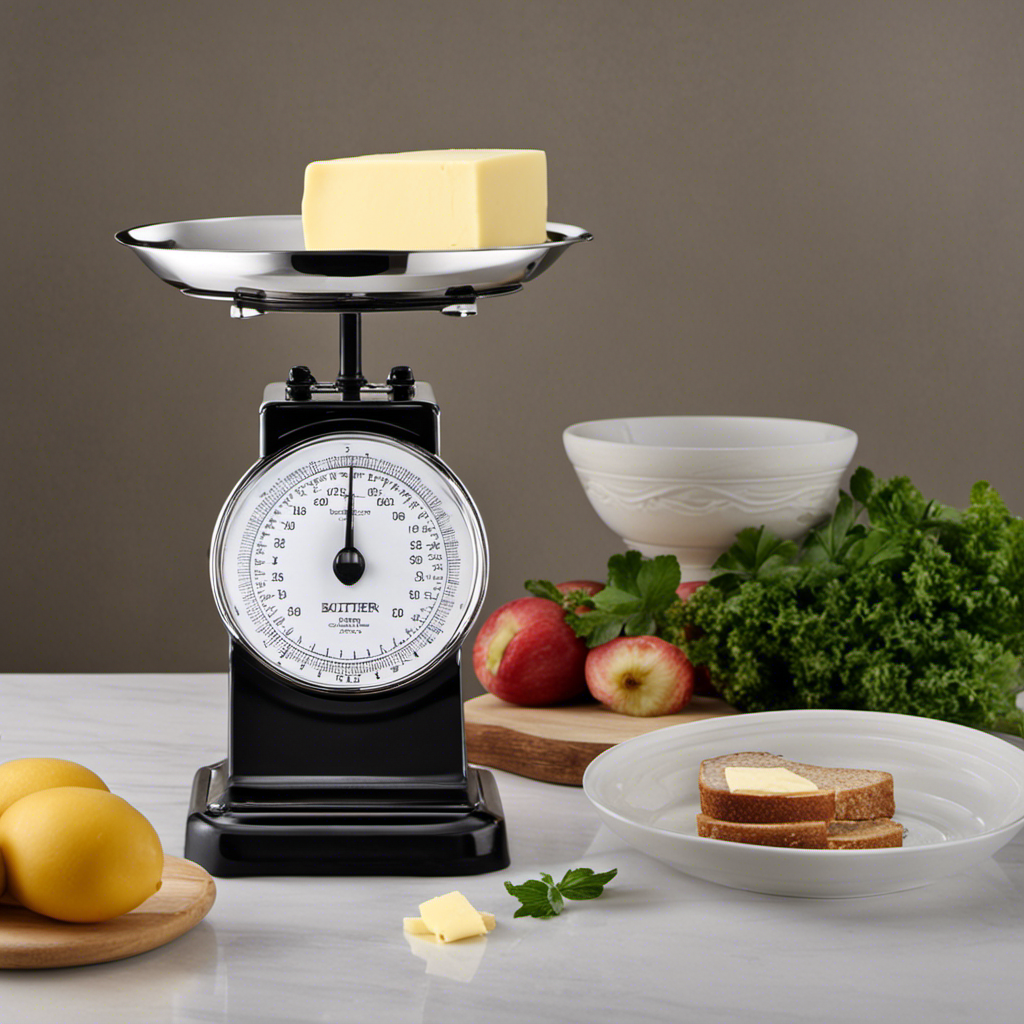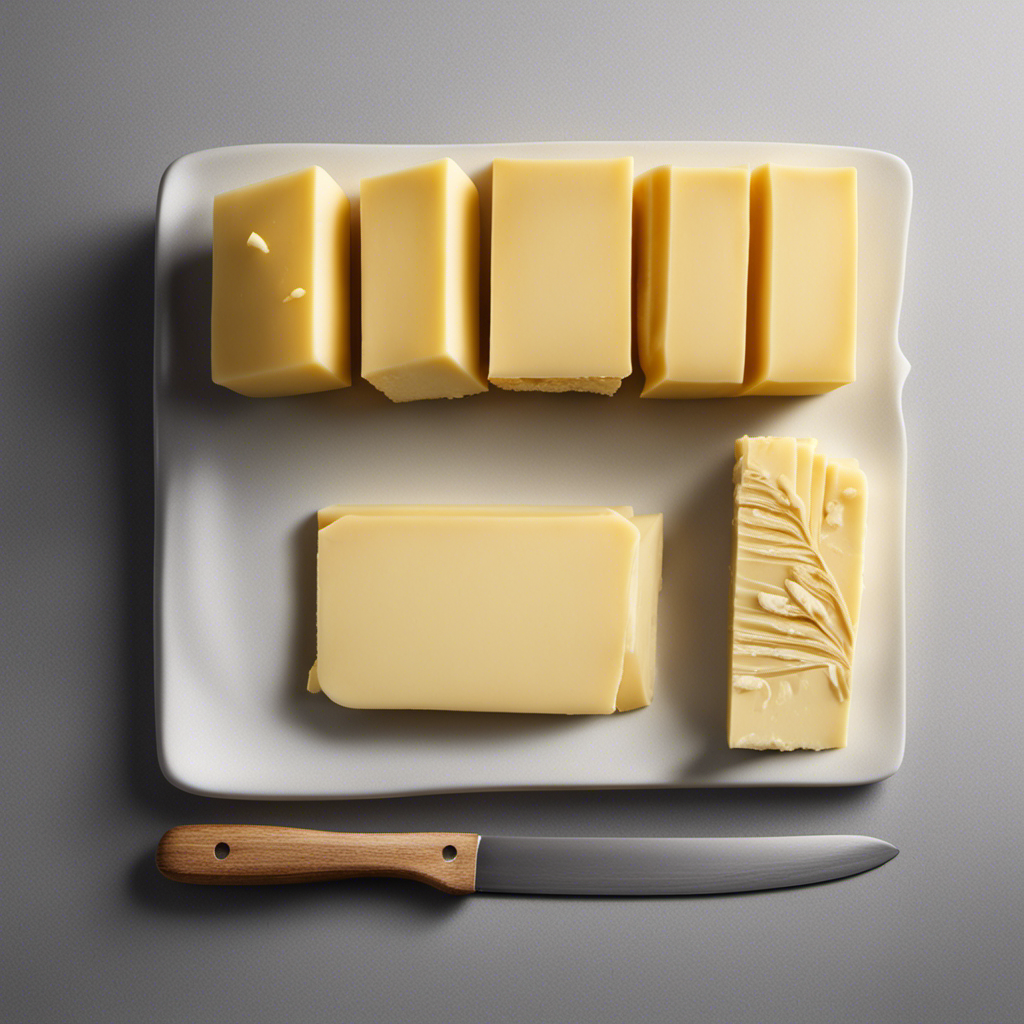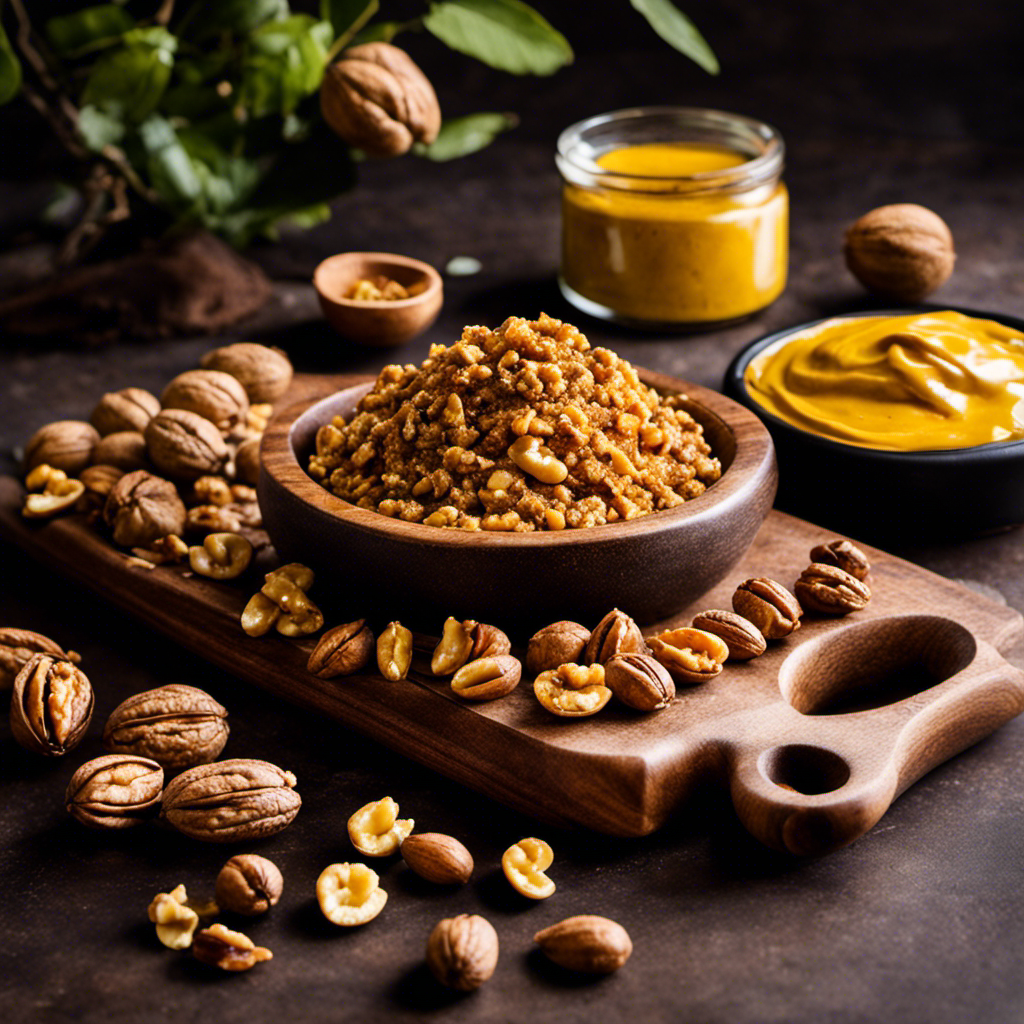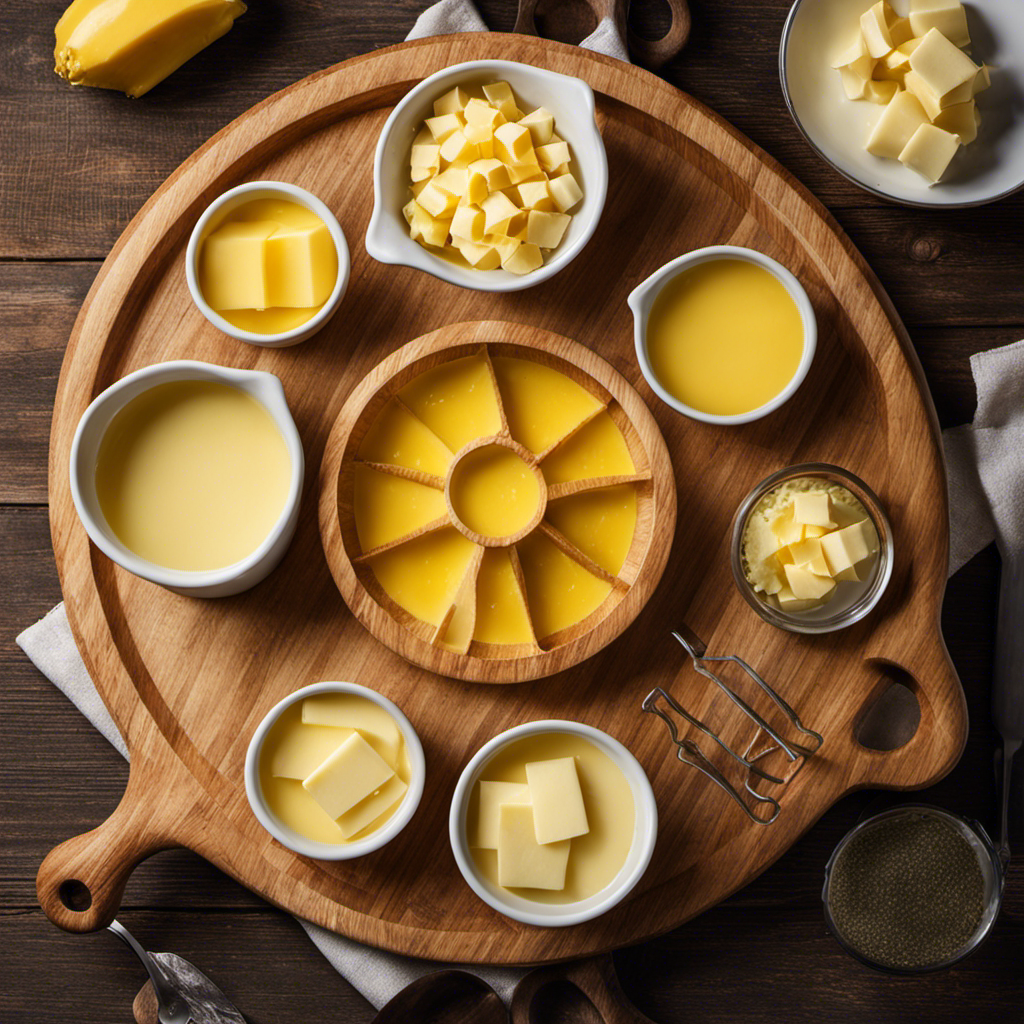Have you ever thought about how many grams are in 4 tablespoons of butter? Well, I have the answer for you.
As a food scientist, I’m here to provide you with accurate and precise measurements when it comes to converting tablespoons to grams of butter.
In this article, we’ll dive into the importance of measuring butter in grams, how to calculate grams for different butter brands, and tips for accurately measuring butter.
Get ready to become a butter-measuring pro!
Key Takeaways
- Measuring butter in grams provides precise and accurate measurements for cooking and baking.
- Converting tablespoons to grams requires the use of a kitchen scale for precise measurements and factors such as temperature and type of butter should be considered.
- Understanding the weight of butter and using reliable sources and specific recipe instructions are important for consistent and successful culinary creations.
- Calculating grams for different butter brands requires consideration of butter density, temperature, type (salted or unsalted), and variation in nutritional content.
The Importance of Measuring Butter in Grams
You should understand the importance of measuring butter in grams.
As a food scientist, I can provide precise measurements and accurate information when converting tablespoons to grams of butter. By using scientific knowledge and reliable sources, I can ensure the information is correct, informative, and educational.
My writing style aims to educate the reader about the topic, providing relevant details about the composition and nutritional content of butter. I will also explain any factors that may affect the conversion, such as temperature or type of butter.
It is important to approach this topic objectively and unbiasedly, presenting factual information based on scientific evidence. The conversion from tablespoons to grams allows for precise measurements, ensuring accurate and consistent results in cooking and baking.
Converting Tablespoons to Grams: A Handy Guide
Converting tablespoons to grams can be a helpful guide for measuring ingredients. As a food scientist, I strive to provide precise measurements and accurate information when discussing the conversion of tablespoons to grams of butter.
To educate you on this topic, I will provide relevant details about the composition and nutritional content of butter. Here are some key points to consider:
-
Converting tablespoons to milliliters: It is important to note that 1 tablespoon is equivalent to 14.79 milliliters.
-
Benefits of using a kitchen scale: Using a kitchen scale allows for more precise measurements, ensuring accuracy in recipes.
-
Factors that may affect the conversion: The temperature and type of butter can influence the weight of tablespoons. Softened butter may weigh less than cold butter.
-
Objective and unbiased approach: I will present the information objectively, relying on scientific evidence and reliable sources.
Understanding the Weight of 4 Tablespoons of Butter
Understanding the weight of 4 tablespoons of butter can be helpful for accurately measuring ingredients in recipes. As a food scientist, I can provide accurate and precise information on converting tablespoons to grams of butter. To help you visualize this conversion, here is a table showcasing the weights of different amounts of butter:
| Tablespoons | Grams |
|---|---|
| 1 | 14.18 |
| 2 | 28.35 |
| 3 | 42.52 |
| 4 | 56.70 |
This table can serve as a handy guide when you need to convert tablespoons of butter to grams. It is essential to note that the weight of butter can vary depending on factors such as temperature and type of butter. To ensure accuracy, always refer to reliable sources and take into account any specific instructions provided in your recipe. By understanding butter density and converting tablespoons to ounces, you can confidently measure butter for your culinary creations.
How to Calculate Grams for Different Butter Brands
Calculating the weight of various butter brands in grams can be helpful for precise measurements in recipes. As a food scientist, I aim to provide accurate and informative information about converting tablespoons to grams of butter.
Here are some key points to consider when comparing different butter brands:
- Butter density: Each brand may have a slightly different density, affecting the weight of a tablespoon of butter.
- Temperature: The temperature of the butter can also impact its density, leading to variations in weight.
- Type of butter: Different types of butter, such as salted or unsalted, may have different compositions that affect their weight.
- Nutritional content: It’s essential to consider the nutritional content of butter, including fat and moisture content, which can vary between brands.
Tips for Accurately Measuring Butter in Grams
When it comes to butter measurement conversions, precision is key.
As a food scientist, I aim to provide accurate information on converting tablespoons to grams of butter.
By using scientific knowledge and reliable sources, I can ensure that the information I present is correct, informative, and educational.
Additionally, I will provide relevant details about the composition and nutritional content of butter, as well as explain any factors that may affect the conversion, such as temperature or type of butter.
My objective and unbiased approach will focus on providing factual information based on scientific evidence, avoiding personal opinions or subjective statements.
Butter Measurement Conversions
To know how many grams 4 tablespoons of butter is, you can convert the measurement using a conversion chart. As a food scientist, I aim to provide accurate and precise information about butter measurement equivalents and converting butter measurements. Here are some key points to consider:
- A standard conversion for butter is 1 tablespoon = 14.18 grams.
- So, 4 tablespoons of butter would be equivalent to approximately 56.72 grams.
However, it’s important to note that the exact weight may vary depending on factors such as temperature and the type of butter (salted, unsalted, whipped, etc.). To get the most accurate measurement, it is recommended to weigh the butter using a kitchen scale.
Precision in Butter Measurement
When it comes to baking, precision is key. As a food scientist, I understand the importance of accurate measurements, especially when it comes to butter.
Measuring butter in ounces and cups is a common practice, but what if you need to convert tablespoons to grams? To ensure the reliability of my information, I rely on scientific knowledge and reliable sources.
The conversion of tablespoons to grams can vary depending on factors such as temperature and type of butter. It’s essential to consider the composition and nutritional content of butter when making these conversions.
Grams for Accurate Recipes
Accurate recipes require precise measurements, which can be achieved by converting tablespoons into grams. As a food scientist, I understand the importance of providing accurate information when it comes to converting tablespoons of butter into grams. To educate you about this topic, I will provide you with the following details:
-
Converting tablespoons to milliliters: To accurately measure butter, it is helpful to convert tablespoons to milliliters, as this provides a more precise measurement.
-
Benefits of using a kitchen scale: Utilizing a kitchen scale allows for even greater accuracy in measuring butter, as it provides exact gram measurements.
-
Composition and nutritional content of butter: Understanding the composition and nutritional content of butter is essential when converting tablespoons to grams, as it can vary depending on the type of butter used.
-
Factors affecting the conversion: Temperature and type of butter can affect the conversion from tablespoons to grams, so it’s important to consider these factors.
By providing you with this objective and unbiased information, I aim to help you make accurate measurements in your recipes.
Now, let’s move on to discussing common mistakes when measuring butter in tablespoons and how to avoid them.
Common Mistakes When Measuring Butter in Tablespoons and How to Avoid Them
When it comes to converting tablespoons of butter to grams, it’s important to have accurate measurements. As a food scientist, I rely on scientific knowledge and reliable sources to ensure the information I provide is correct, informative, and educational.
In this discussion, I will provide helpful tips on proper tablespoon butter conversion, avoiding inaccurate measurements, and share valuable measuring techniques to ensure precise results.
Proper Tablespoon Butter Conversion
To properly convert tablespoons of butter to grams, you can use the following formula:
- 1 tablespoon of butter = 14 grams
Accurate measurements are crucial when it comes to cooking and baking. Using the correct amount of ingredients ensures the desired outcome of your recipe. When converting tablespoons of butter to grams, it is important to be precise.
A digital scale can be an invaluable tool in achieving accurate measurements. Here are some benefits of using a digital scale:
-
Provides precise measurements: A digital scale displays measurements in grams, allowing for more accuracy compared to using tablespoons.
-
Consistency: Using a digital scale ensures consistent results every time you cook or bake.
-
Versatility: Digital scales can be used for measuring other ingredients as well, such as flour, sugar, or liquids.
-
Time-saving: With a digital scale, you can quickly and easily measure ingredients without the need for multiple utensils or guesswork.
Avoiding Inaccurate Measurements
When it comes to measuring butter alternatives, it’s important to be precise and accurate. As a food scientist, I want to ensure that the information I provide is correct and informative. Converting butter measurements can be tricky, but with the right knowledge, it can be done effectively.
To convert tablespoons of butter to grams, it’s essential to consider the type of butter and its composition. Different types of butter may have slightly different densities and moisture content, which can affect the conversion. Additionally, the temperature of the butter can also play a role in its weight.
Using scientific knowledge and reliable sources, I can provide you with the most accurate conversion. By understanding the composition and nutritional content of butter, we can make informed decisions when it comes to measuring butter alternatives.
Stay tuned for the next section, where I will dive deeper into this topic.
Helpful Measuring Tips
One helpful tip for accurate measurements is to make sure you level off the ingredient with a straight edge. This ensures that you are using the exact amount required for your recipe.
When converting tablespoons to grams of butter, it is important to be precise and avoid common misconceptions. Here are some helpful measuring tips:
- Use a flat surface, such as a countertop or cutting board, to level off the tablespoon of butter.
- Use a digital scale for more accurate measurements.
- Take into consideration the temperature of the butter, as it can affect its weight.
- Different types of butter may have slightly different densities, so it is important to refer to a reliable source for conversion factors.
Frequently Asked Questions
Can I Use a Different Measuring Unit Instead of Grams to Measure Butter?
You can use different units to measure butter, such as ounces. Converting tablespoons of butter to ounces can be done by multiplying the number of tablespoons by 0.5, since there are 0.5 ounces in one tablespoon.
What Is the Equivalent Measurement of 4 Tablespoons of Butter in Cups?
To convert tablespoons of butter to grams, you can use a conversion chart or an online calculator. It is important to note that the conversion may vary depending on the type and temperature of the butter.
Are There Any Substitutes for Butter When Baking?
When it comes to vegan baking or finding butter substitutes, there are several options available. Some common substitutes include coconut oil, avocado, or nut butters. Experimenting with these alternatives can lead to delicious and dairy-free results.
How Can I Accurately Measure Butter Without a Kitchen Scale?
When measuring butter without a scale, visual cues can be helpful for accurate measurements. For example, 4 tablespoons of butter is approximately 56 grams. Remember to consider factors like temperature and type of butter for precise conversions.
Can I Use Margarine Instead of Butter in a Recipe That Calls for 4 Tablespoons of Butter?
Yes, you can substitute margarine for butter in a recipe that calls for 4 tablespoons of butter. Another alternative is butter flavored shortening.
Conclusion
In conclusion, it is crucial to measure butter in grams for accurate and precise cooking and baking. Converting tablespoons to grams is a handy guide that ensures consistency in recipes.
Understanding the weight of 4 tablespoons of butter helps in achieving the desired results in your culinary endeavors. By calculating grams for different butter brands, you can adjust your measurements accordingly.
Remember to measure butter in grams accurately to avoid common mistakes and ensure delicious outcomes. Trust in scientific knowledge and reliable sources to provide informative and educational information about butter conversions.










